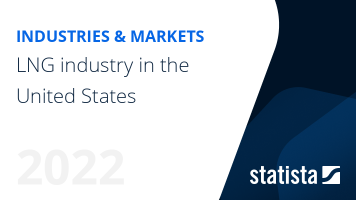Global LNG industry - statistics & facts
LNG export market and largest players
Advancements in hydraulic fracturing processes have made the United States the largest natural gas producer in the world. In 2016 Cheniere Energy became the first company to sell U.S.-sourced LNG to overseas customers. Since then, Cheniere has grown to become the second largest LNG exporting company, with a storage capacity of 44 million metric tons per annum. It is one of the smaller players in the export market as the industry is largely dominated by oil and gas supermajors and state-owned giants such as Qatar Energy. Along with the U.S., Qatar and Australia account for the greatest LNG export market share.Main importers and the potential for LNG growth in Europe
The countries most reliant on LNG imports are those where their remote location makes pipeline connections unfeasible. For many years, Japan and South Korea have been among the largest LNG importing countries, while China's growth in import volumes has been more recent. The spot price for LNG delivered in China averaged 10.05 U.S. dollars per million British thermal units in January 2024.Due to the vast network of pipelines connecting Russian gas producers and European consumers, LNG used to play only a minor role in European trade. However, as the Russia-Ukraine war unfolded, many government leaders on the continent prioritized finding alternative means of acquiring natural gas. Due to its importance for many industrial manufacturing sectors and the generation of heat and electricity, the LNG market in Europe has grown in significance.



































